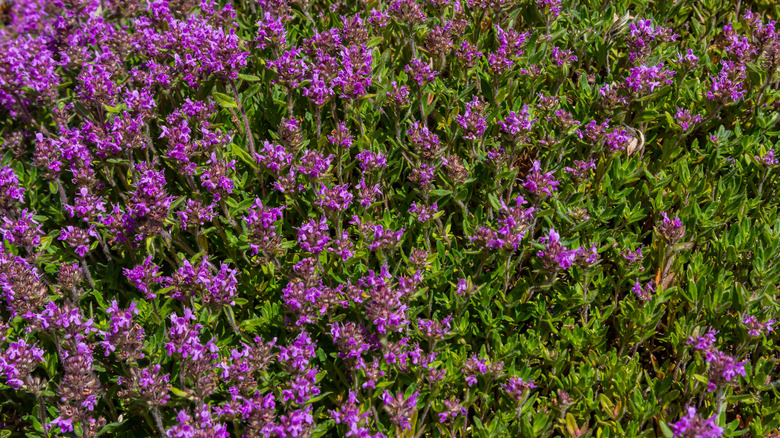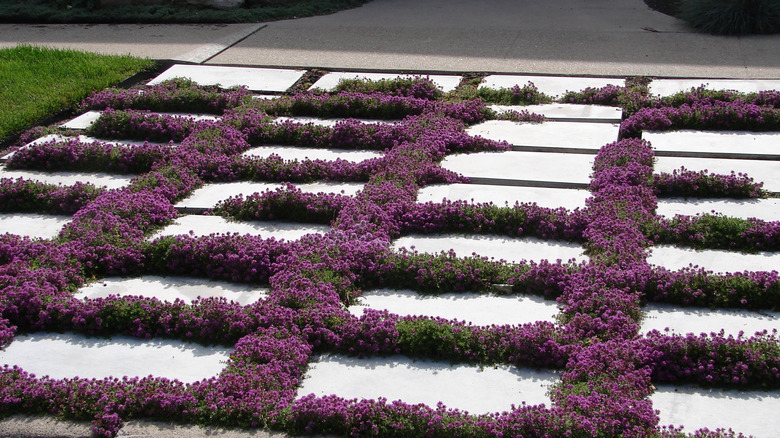Grow This Ground Cover Plant To Naturally Avoid Weeds In Your Lawn
Creeping thyme (Thymus serpyllum) has become one of nature's most effective solutions for creating a lush, weed-resistant ground cover for your lawn. This perennial herb creates a dense mat of foliage that chokes out weeds by physical crowding and chemical inhibitors that help attack the root systems. Unlike normal grass that requires constant weeding, creeping thyme grows fast and thick, leaving little room for unwanted plants to grab hold. Creeping thymes' tiny leaves also release a nice herbal scent when walked on, transforming your yard into a fragrant landscape that thrives with minimal care once established.
There are some common mistakes you'll want to avoid when planting creeping thyme as ground cover, but overall it is a simple process that just requires a little planning. The plant's dense growth will physically block sunlight from reaching weed seeds that might be in your soil. Its natural oils create an inhospitable environment for common lawn weeds. Unlike chemical treatments or physical barriers, like plastic sheets, creeping thyme is an eco-friendly solution that improves over time as the plant spreads to fill empty space. It is drought-tolerant, adapts well to different types of soil, and requires zero mowing. From late spring through early summer, creeping thyme will produce small purple or pink flowers that attract pollinators, making it both functional and pretty.
How to successfully plant (& care for) creeping thyme
Planting creeping thyme as a weed-suppressing ground cover will require planning and proper technique. Begin by preparing the area in early spring or fall by removing the existing weeds and grass. Consider soil solarization as a way to get rid of weeds in tougher areas of your lawn. Space young thyme plants around 8 to 12 inches apart in the soil, as they will quickly fill the gaps. For larger areas, mix new seeds with sand to help distribute them evenly, though germination from seeds does require time and patience. Make sure you keep the seeds moist for the first month, then you can gradually reduce to weekly watering as the roots begin to develop.
As time passes, you'll want to encourage the creeping thyme's dense growth while managing its spread. Apply a thin layer of gravel around plants to help improve drainage and as an extra barrier to discourage weeds. Unlike normal grass lawns, creeping thyme does well in poor soil and does not often need extra fertilizers. Annual pruning after the flowers have bloomed will help maintain the compactness of the plant. Simply shear back one-third of the growth using garden scissors or a string trimmer. For high-traffic areas, consider adding stepping stones to protect the thyme while still allowing it to cover most of the ground. Creeping thyme should fill in completely within two growing seasons, at which point its weed-suppressing abilities should be in full swing.
Important things to consider before planting creeping thyme
There are some important things to know before planting creeping thyme as ground cover. There are plenty of benefits. However, certain situations might not make it the best choice for you and your lawn. The thyme will struggle in areas with heavy clay or constantly wet soil where root rot could become a risk. It does take time to grow out completely, so you will need to be diligent in your weeding during the first couple of seasons before it has fully established itself. Some people may also find the scent to be overwhelming when planted near high-traffic areas. The plant itself is non-toxic, but the essential oils that it produces could irritate sensitive paws of pets who like to dig around in the lawn.
Seasonal limitations should also be taken into consideration. In colder climates, thyme may begin to scale back in the winter. This could leave temporary bare spots that weeds will try to take hold of. The plant's flowering period is beautiful but attracts bees and other pollinators. This could be a concern for families with allergies or small children who play barefoot. Unlike a normal grass lawn, creeping thyme cannot handle heavy recreational use like sports or frequent pet runs. However, with proper planning around these considerations, creeping thyme remains one of the most effective solutions for reducing weeds and gives your lawn a unique beauty that stands out.


